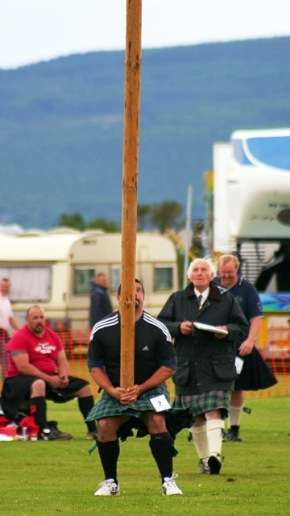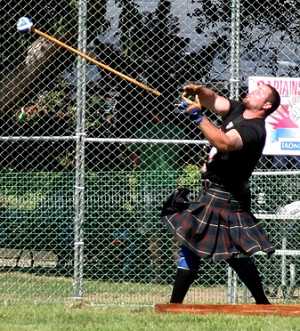HIGHLAND GAMES: This guide explains the Highland Games events rules associated with Scotland.
Each year, the long and proud history of the Scottish Highland Games events celebrate the Gaelic culture and heritage of Scotland.
Popular Highland Athletic Events
The costumed challengers compete in traditional Highland attire with kilt and a sporran. They wear them most for the putting and throwing activities in the heavy events section.
Shot putting, throwing the weight, and tossing the caber rules, all belong in this section of the Highland Games. The triple jump, the pole vault, and the high jump are three of the athletic events.
Other emblematic events also include competitions held in drumming, piping, dancing, tug-o’-war events, cycling, and the unique Cumberland and Westmoreland wrestling. They will get contested to the background sounds of the distinctive Scottish bagpipes.
Note: Most Highland Games Rules are not too difficult to understand. But they are often interpreted ‘ad-lib‘!
1. Caber Toss Rules (Scottish Log Throwing Sport)
Tossing the Caber rules is one of the best known. It belongs with the Highland traditional heavy events. Caber originates from the Gaelic word ‘cabar‘ meaning wooden beam or long tapered pole – like a log.
Highland Games Log Throwing Technique
 Where does the technique of Scottish pole throwing, or tossing the caber, derive from? It comes from a need to toss long tall logs across narrow chasms many years ago in the Scottish highlands.
Where does the technique of Scottish pole throwing, or tossing the caber, derive from? It comes from a need to toss long tall logs across narrow chasms many years ago in the Scottish highlands.
Cabers used in the games weigh around 80 kilograms. Even so, they do vary in weight, taper, and length.
It is usually a section of a Larch tree measuring 5.95 meters tall. This length complies with the Scottish Highland Games rules.
The competitor gets called the ‘tosser‘ in Highland Games terminology.
He hoists and balances a long pole vertically against his neck and shoulder. He does this while holding the tapered narrow end downwards.
The objective is to run or pace forwards to build momentum and toss the caber end over end so that it flips. The large upper end hits the ground first and the Highland Games pole falls away from the thrower.
Tossing the Caber Scoring Rules
When the caber gets tossed successfully they will have ‘turned the caber‘. It should resemble the vertical angle of the large hand of an imaginary clock when it is in the 12 o’clock position.
As a rule, the competition allows three attempts per entrant for the caber tossing event. Highland judges score a straight end-over-end toss with the highest points.
Note: Distance thrown in the Scottish caber toss is irrelevant to these particular Highland Games events rules.
2. Highland Games Stone Put
It is easy to mistake the Scottish heavy athletic event in the highland stone put competition for a modern-day Olympic Games shot put event.
Yet, the rules of putting the stone and event techniques are different. The highlanders use a large stone or rock weight as opposed to the steel shot used in the Olympics.
Braemar and Open Stone Putting Events
The allowable techniques and stone weights vary according to the event. Male athletes throw a 20–26 pound stone and women 13–18 lb. in the Braemar Stone throws.
The standing put event does not allow any run up to the toe board (trig). Men throw a 16–22 lb. stone (8–12 lb. for women) in the Open Stone challenge. Any one-handed throwing style is within the rules. Even so, the spin or glide techniques seem to be most effective.
3. Highland Games Hammer Throw
The Scottish Hammer Throwing Competition entered the Scots games in the late 18th century following the Highland Clearances.
 It has only a few subtle differences to that of the modern-day track and field events. The Highlanders use a spherical metal ball attached to the end of a four foot wooden shaft. The shaft is usually made from bamboo or rattan.
It has only a few subtle differences to that of the modern-day track and field events. The Highlanders use a spherical metal ball attached to the end of a four foot wooden shaft. The shaft is usually made from bamboo or rattan.
The hammer weighs 7.257 kilos for the men’s event and four kilos for the women. Throwing the hammer the farthest distance is the aim of the competition.
Throwers rotate ‘circularly‘ and hurl the hammer around their head. They release it over their shoulder as far away as possible and ahead of the thrower’s circle.
It takes tremendous balance, speed, and strength to keep both feet firmly fixed to the ground. The trick is avoiding the centrifugal force of the throw.
You will find the highland games rules relating to the hammer throw much like normal athletics field events.
In 2014 the world record for hammer throwing stood at 86.74 meters attained in 1986 in West Germany. The women’s record holder threw 79.42 meters in 2011.
The other three throwing events in the regular track and field tournaments are the javelin, the discus throw, and the shot put.
4. Highland Games Weight Throw (Weight Throw for Distance)
The Weight Throw – also called the weight for distance – has a somewhat ‘light’ version for men (28 lb.) and one heavy throwing event (56 lb.). The metal weights get attached to a handle often by a chain. It gets thrown using only one hand and the longest throw wins.
Weight Over the Bar
The weight for height throwing event is less well known. But, each athlete has three separate, ‘single-handed’ attempts to hurl the four stone implement over a horizontal bar. The bar gets set at increasing heights.
Athletes progress to the next round only if they clear the height. The highest toss with the fewest missed throws determines the winner.
5. Highland Games Sheaf Toss
The Sheaf Toss is as much a crowd pleaser at Scots and Irish games as agricultural country fair events. The sheaf is a bundle of straw stuffed inside a burlap fabric bag. As a rule it weighs 20 pounds for men and ten pounds for women.
Contestants use a ‘pole vault‘ like pitchfork to toss the sheaf vertical and clean. It gets hoisted over a bar (without touching it) directly above their head. Successful clean tosses allow the entrants to move to the next round with the bar raised to a higher level.
The sheaf toss is not ‘technically‘ a heavy event for the athletes. But, it is very popular. It is also a traditional contest in Ireland, the Basque Country, and Australia.
6. Maide Leisg Highland Games (Scots Gaelic ‘Lazy Stick’)
Maide Leisg – pronounced ‘made leash‘ – is a tussle of strength and balance. It gets performed while seated on the ground. Two men face one another with the soles of their feet firmly pressing against their opponent’s feet.
At this point they then attempt to raise their competitor off the ground with a stick held in their hands. The world’s oldest ‘Maide-Leisg‘ competition takes place annually at the Highland Games on the Isle of Lewis.
ALSO IN THIS SECTION
A-Z List Sports Rules and Regulations: All popular indoor and outdoor sports categories.
Archery Rules: Shoot through a range of Olympic archery rules and regulations.
Curling Rules: An indoor sporting event using the principles and disciplines of bowls.
Highland Games Terminology: Find 100s of terms and definitions used by competitors and officials.
Unusual Sports Rules: A concise list of weird and wonderful sports games around the world.

